Kali Linux Video Editing Software
A video editor isn’t included in most Linux distributions. While there are creative Ubuntu editions that include video and other tools, ordinary Ubuntu releases do not. In this tutorial, we will discuss the list of various types of video editing software for Kali Linux.
The following is the list of some Kali Linux Video Editing Software
- Natron Compositing Software for VFX and Motion Graphics
- Kdenlive
- Open Shot
- Pitivi
- Shortcut
- Blender
- Flowblade
- LiVES
- DaVinci Resolve Free
- Light Works Free
1. Natron Compositing Software for VFX and Motion Graphics
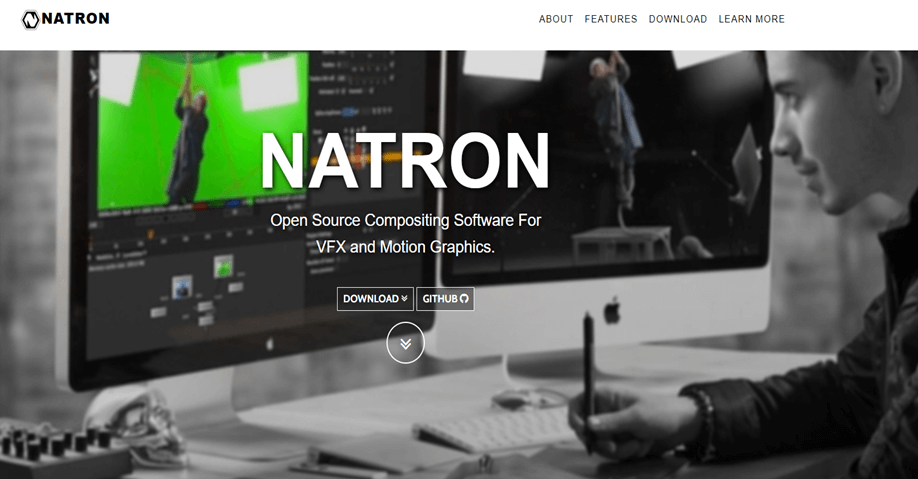
Natron is a node-based compositing application that is free and open-source. Its user interface and many concepts are drawn on digital composting tools like Avid Media illusion, Apple Shake, Blackmagic Fusion, Autodesk Flame, and Nuke.
Plugins that follow the OpenFX 1.4 API are supported by Natron. Most commercial and open-source OpenFX plug-ins are supported.
Natron is a capable 2D/2.5D Digital Compositor. Natron is the flexible open-source compositor for the visual effects community because of its robust OIIO file formats and OpenFX architecture. It has the same interface and functionality on all platforms, including macOS, Linux, and Windows. Natron’s keying, roto/rotopaint, and 2D tracking technologies are essential for any current film production project that needs visual effects.
From 2013 to 2018, Natron was a proud beneficiary of Inria financing, and its community is presently actively developing it.
Features of Natron Compositing Software for VFX and Motion Graphics
The following are the features of Natron compositing software for VFX and Motion Graphics:
- Powerful Tracker
- VFX
- OpenFX plugin support
- Shadertoy and G’mic tools
- Keying tools for production needs
2. Kdenlive
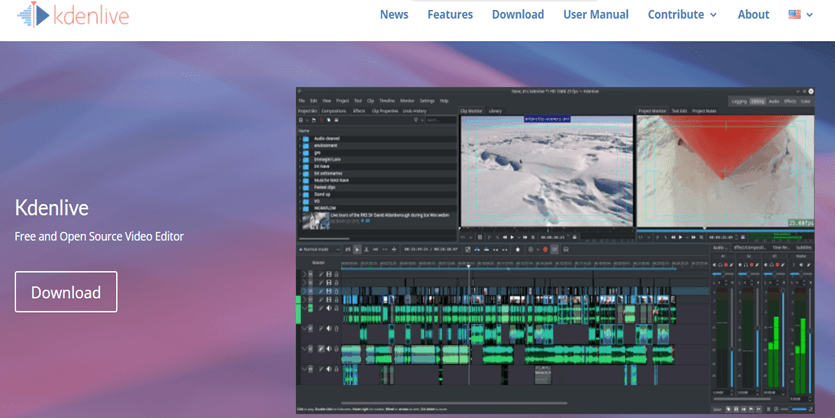
Kdenlive is a free and open-source video editing software that runs on GNU/Linux, FreeBSD, and OS X. Cutting, splitting transitions, video effects, copy-paste, and other video editing features are available. It also supports a wide range of formats and works with a wide range of file formats as well as camcorders and cameras.
It supports various formats from a wide variety of camcorders and cameras, including raw, avi, dv, mpeg2. and Mpeg4, h.264, AVCGD, HDV, XDCAM-HD™ streams, IMX™ (D10) streams, DVCAM (D10), DVCAM, DVCPRO™, DVCPRO50™ streams, and DNxHD™ streams.
Features of Kdenlive
The following are the features of Kdenlive:
- Automatic save
- Multi-track video editing
- Keyframeable effects
- Proxy editing
- Multi-track video editing
- Number of effects and transitions
- A wide range of audio and video formats
- Audio and video scopes ensure that the footage is balanced properly
- Configurable interface and shortcuts
- Easily create tiles using text or images
- Wide hardware support
Pros of Kdenlive
The following are the pros of Kdenlive:
- All-purpose video editor
- For those who are familiar with video editing, it is not too difficult
Cons of Kdenlive
The following are the cons of Kdenlive:
- KDE applications are infamous for being bloated
- If we are looking for something incredibly simple, it may still be complicated
3. Open Shot
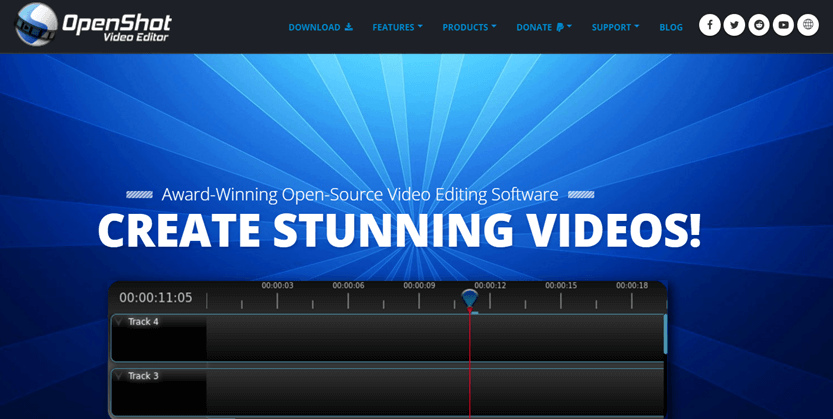
Open Shot is a Python-based video editor for the Linux operating system. It is open-source and free downloadable video editing software. Many music, video, and image formats are supported by its core features. Better drag and drop feature. Cutting, trimming, snapping, and cropping are all easier in open shot. It also supports video transition, 3d effects, and motion picture credits. The open shot is a user-friendly software that supports keyframe animation, digital zooming, editing, video encoding, and audio and digital video effects mixing.
This video editor software includes a compositing tool as well as a more comprehensive editing tool for working with HDV and AVCHD video.
Features of Open Shot
The following are the features of Open Shot:
- Supports a variety of audio, video, and image formats
- Powerful curve-based keyframe animations
- Audio mixing and editing
- Video transition with real-time previews
- Cross-platform, available on Windows, Linux, and macOS
- Compositing, image overlays, and watermarkss
- Frame accuracy (step through each frame of video)
- Time-mapping and speed changes on clips
- Digital video effects, including brightness, gamma, hue, chroma-key, greyscale, etc.
- 3D animated titles and effects
- Unlimited track or layers
- Desktop integration with drag and drop support
- SVG friendly for creating, and including vector titles and credits
- Clip resizing, scaling, trimming, rotation, snapping, and cutting
- Scrolling motion picture credits
- Title templates, title creation, sub-titles
- Support for 2D animation via image sequences
- Audio mixing and editing
Pros of Open Shot
The following are the pros of open shot:
- It is available on Linux, Windows, and macOS
- All-purpose video editor for average video editing needs.
Cons of Open Shot
The following are the cons of Open Shot:
- It may appear straightforward, but there is a learning curve here if we are entirely new to video editing.
- We may still be unable to locate software that meets the standard of professional-grade video editing.
4. Pitivi
Pitivi is another excellent free and open-source video editor. It makes use of the Gstreamer framework to import/export and renders media. Pitivi helps with simple activities like:
- Trimming
- Snapping
- Splitting
- Cutting
- Mixing
Audio and video clips can be linked together and handled as a single clip. Pitivi may also be used in a variety of languages and has extensive documentation, which we personally find beneficial. Learning how to use this software is simple and takes little time. We will be able to edit video and audio files with great precision once we’ve become used to it.
The user-friendly interface of Pitivi allows for drag-and-drop, direct manipulation, and native theme navigation. This software can be translated into a variety of languages, and it also comes with a user manual.
Pitivi generates thumbnails and waveforms in the background to provide the finest possible results without interfering with our workflow.
Features of Pitivi
The following are the features of Pitivi:
- Simple to use crossfades and SMPTE transitions
- Multihead-friendly with detachable user interface components
- Ability to set custom aspect ratios, framerates, and rendering pre-sets
- Can animate a number of special effects and filters with keyframable properties
- Accepts any file formats supported by the GStreamer multimedia framework
5. Shortcut
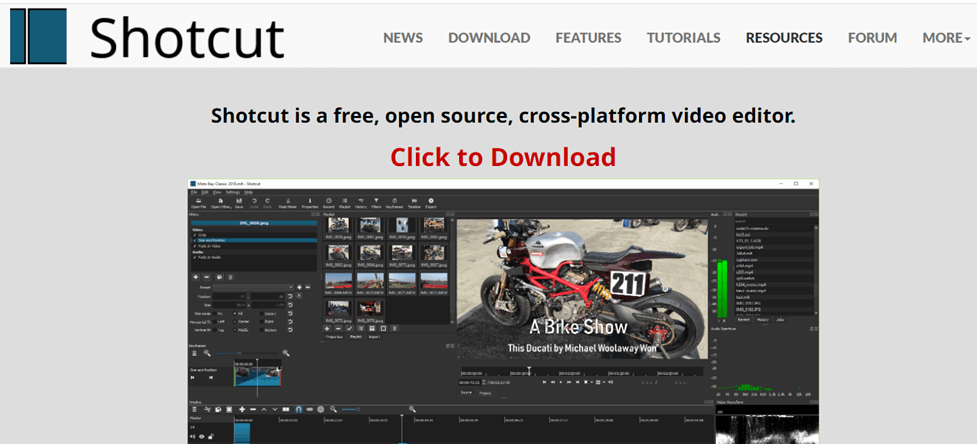
A Shortcut is another video editor for Linux that might be compared to Kdenlive and OpenShot. The Shortcut is a bit more complex than the other two mentioned above, including support for 4k videos.
The Shortcut has several capabilities, including support for a variety of audio and video formats, transitions, and effects. An external monitor can also be used.
With a variety of valuable features, the software makes video editing a breeze. It will suffice for most purposes, but it may not be the ideal solution if we require more powerful features such as advanced professional video or audio recording. However, it qualifies as a respectable video editor for Linux due to its features.
Features of Shortcut
The following are the features of the shortcut:
- Video transitions and filters
- Cross-platform, available on Windows, Linux, and macOS
- Native timeline editing
- It supports a wide range of audio, video, and image formats
- Hardware support
- Audio filters, mixing, and effects
- Mix and match resolutions and frame-rates within a project
- External monitoring on an extra system display/monitor
- Clip resizing, trimming, snapping, scaling, rotation, and cutting
- Multitrack timeline with thumbnails and waveforms
- Unlimited undo and redo for playlist edits, including a history view
- EDL (CMX3600 Edit Decision List) export
- Network stream playback (HTTP, HLS, RTMP, RTSP, MMS, UDP)
- No import needed- native timeline editing
- Audio capture
- Webcam capture
- Frame-accurate seeking for various formats
Pros of Shortcut
The following are the pros of shortcut:
- Support for 4K videos
- All-purpose video editor for common video editing requirements
- It is available for Linux, Windows, and macOS
Cons of Shortcut
The following are the cons of shortcut:
- Too many features harm the software’s simplicity
6. Blender
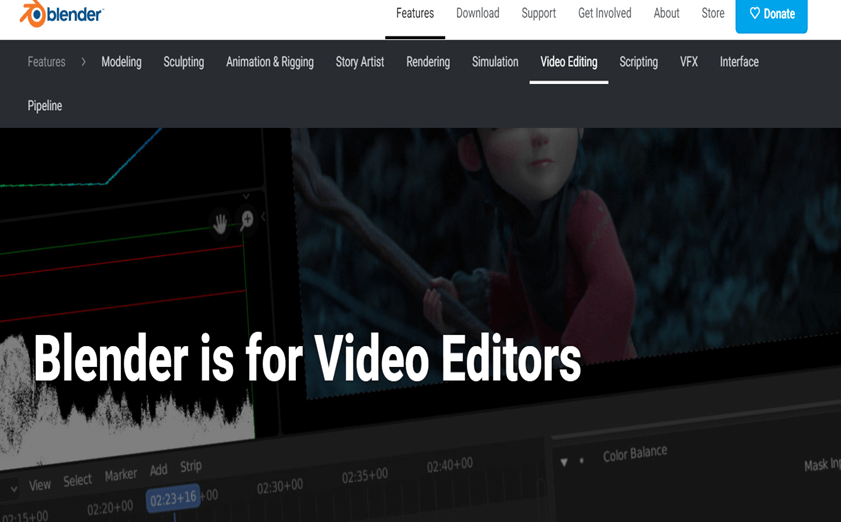
Blender is a 3D computer graphics software. It’s also open-source and freely available, mainly for visual effects, animated films, video games, and 3D interactive applications. This software is written in C, C++, and Python. This software has various features like skinning, 3D modelling, UV unwrapping, texturing, fluid simulation, and smoke, etc.
Rendering, video graphics editing, animation, match moving, sculpting, compositing, camera tracking, particle and soft body simulation. Geometric primitives, including 3D vector graphics, are also supported. Its scan-line ray tracing can be exported to a variety of systems for use in the internal render engine.
Features of Blender
The following are the features of Blender:
- Audio mixing, syncing, scrubbing, and waveform visualization
- Up to 32 slots for adding video, audio, images, masks, scenes, and effect
- Speed control, transitions, keyframes, filters, adjustments, etc
- Live preview, chroma vectorscope, luma waveform, and histogram displays
Pros of Blender
- Professional-grade editing
- Cross-platform
Cons of Blender
- Mainly for 3D animation, not focused on regular video editing
- Complicated
7. Flowblade
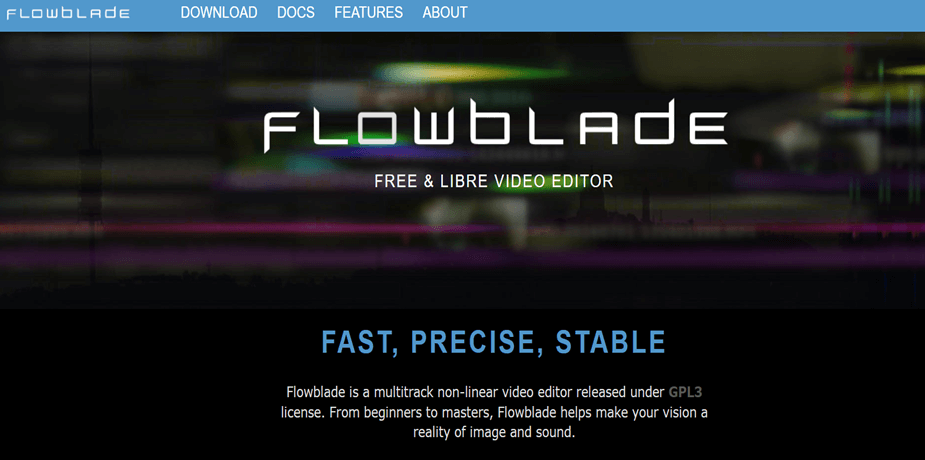
Version 0.12 of flow blade movie was released for Linux in January 2014, and version 0.14 is in the pipeline to be released in June 2014. It’s a multitrack nonlinear video editor that allows for more precise and quick editing.
It features a wide range of tools and techniques to provide the greatest audio-video editing experience. There are two movements and three trim tools, as well as four different ways to append, overwrite, and insert a clip in the timeline.
This video editor also features more than 50 image filters and 30 audio filters to offer the best possible video and audio editing results.
Features of Flowblade
The following are the features of Flowblade:
- Watermarks
- Supports proxy editing
- Lightweight application
- Offer a simple interface for simple tasks such as a split, merger, overwrite, etc.
- Video transitions and filters
- Multitrack timeline with thumbnails and waveforms
- Plenty of audio and video effects and filters
- Batch rendering
- Drag and drop support
Pros of Flowblade
The following are the pros of flowblade:
- Best for general-purpose video editing
- Lightweight
Cons of Flowblade
- Not available on other platforms
8. LiVES
LiVES is a free video editing software and VJ tool that is released under the GNU General Public License version 3 or later. Binary versions are available for most popular Linux distributions such as Debian, Fedora, Ubuntu, Gentoo, Arch Linux, Suse, Mageia, and Mandriva. There are also BSD ports, as well as Solaris and IRIX support. It was compiled on OS X Leopard, but it has not been properly tested on that platform.
A version for Microsoft Windows was announced in early 2019, with a release data set for the second part of 2019.
It provides seamless forward and reverses playback at various frame speeds. Frame accurate cutting and pasting within and between clips are supported. LiVES, like most strong video editors, can work with live firewire cameras and television cards.
It can load mp3, mod, Vorbis, xm, it, and wav files in the Audio editing section. Trimming audio to suit video parts is possible. Silence can be (auto) inserted, and audio parts can increase its functionality if necessary.
LiVES is a new addition to the community. As a result, it is not available in the app stores of Linux distributions and we will have to build it from the ground up.
Features of LiVES
The following are the features of LiVES:
- Frame and sample-accurate editing
- VJ keyboard control during playback
- Edit video in real-time
- Plugins supported
- Compatible with several effects frameworks: project, LADSPA audio, etc.
- Multi-track support
- It can be controlled using a keyboard, Joystick, MIDI
9. DaVinci Resolve Free
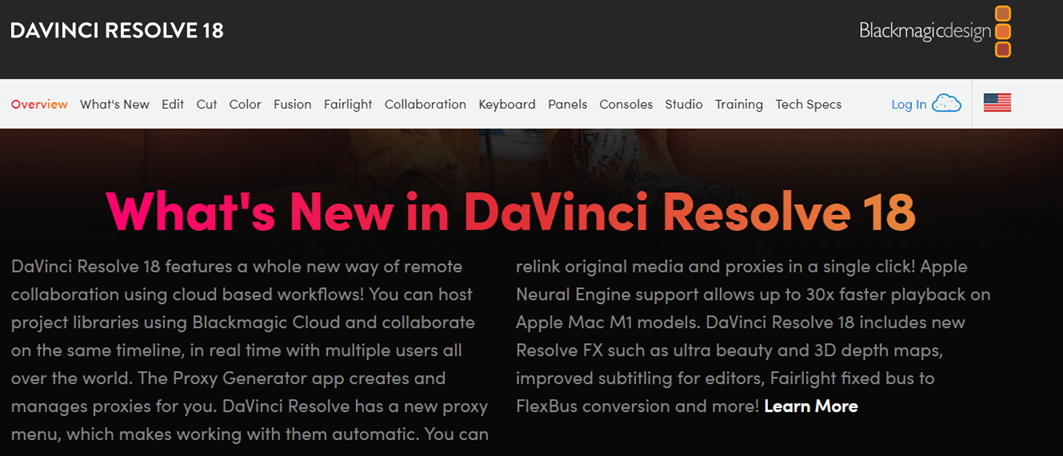
This is the most professional Linux video editor currently available. DaVinci Resolve is a powerful video editor that is widely utilized by Hollywood film studios. It has unique features, including editing, colour correction, and professional audio post-production, enabling professionals to create TV shows and movies.
It’s an all-in-one suite with several editors, including assistants, colourists, and VFX artists. The sound designers might also work on the same project at the same time. It also allows non-linear visual effects.
DaVinci Resolve comes with full Fusion visual effects and monitors graphics already installed. The Fusion page provides comprehensive 3D compositing. Vector paint, text animation, tracking, rotoscoping, particles, stabilization, etc.
Other features comprise a new LUT browser, multiple playheads, and shared grades. Stacked timelines, on-screen annotations, subtitle and closed captioning tools, etc.
DaVinci Resolve is not free due to its professional-grade functionality. We can still try the software’s free edition to determine if it’s right for our video editing needs.
10. LightWorks Free
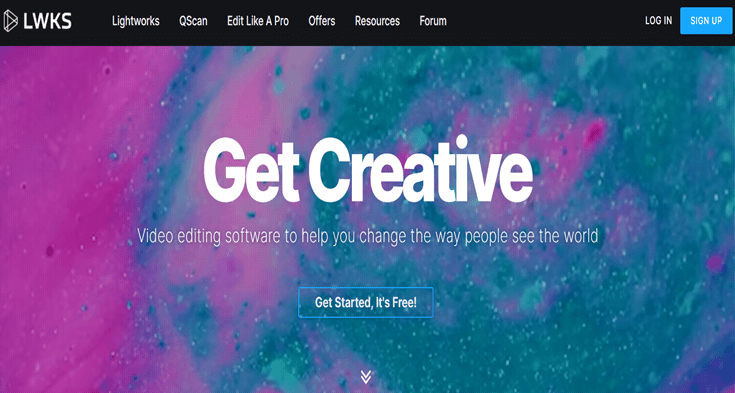
The LightWorks video editor is best suited for video editing specialists because the functions go beyond the realm of inexperienced editors. The award-winning non-linear editing (NLE) software supports 4K, Blu-Ray, and even SD and HD video formats. We will also find Low-Res Proxy workflows for 4K and drag-and-drop support alongside those capabilities.
It contains a voice-over, and Mackie MIDI support for Linux users was just added. Lightworks supports the most analogue and digital connections, including 12G, 3G-SDI, Optical audio, and HDMI 2. And AES/EBU connectors.
Professional-level video and audio filters and effects have also been included by the creators. Unfortunately, there are two versions of this software available: Lightworks Free and Lightworks Pro. The distinction is that the latter supports a variety of video formats while the former does not. Lightworks is compatible with both Windows and Mac OSX.
Features of LightWorks Free
The following are the features of LightWorks Free:
- Multicam editing
- Realtime effects
- Ability to import a variety of file types
- Second monitor output
- Export to YouTube (H.264/MPEG-4) up to 720p
- Export to Vimeo (H.264/MPEG-4) up to 72-p
